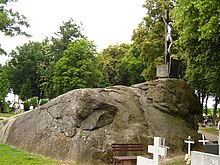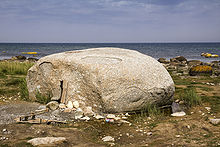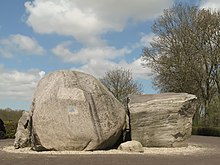Boulder

A boulder is a very large stone , usually lying on its own, which was transported through glaciers during the Ice Ages and stored at its current location. When the ice melts and the glacier retreats, they remain as boulders. Erratic blocks are the most common form of erratic blocks . The boundary between erratic boulders and the smaller debris is drawn with a volume of one cubic meter.
distribution


Erratic boulders are a typical geological and geomorphological distinguishing feature of landscapes that have been or are formed by glaciers. In Europe , these are in particular the Scandinavian Peninsula (including northern Central and Western Europe) and the glaciation area around the Alps .
Formation of the erratic blocks
A glacier as a solid body does not sort the material ( moraine ) it transports . This applies to the uptake of the rock (by erosion or fall onto the glacier), transport and deposition (sedimentation). Large fragments of rock are removed either by absorbing loosened stones when the glacier crosses them, or by freezing and breaking out blocks at the bottom of the glacier. The latter happens mainly on lee slopes of round humps . When mountains tower over the glaciers, such as in the Alps, rock can also fall onto the glaciers from above; such boulders generally show sharper, not more rounded breaking edges. As a solid body, the glacier is easily able to move material from the minimum grain size of the clay minerals to chunks of over ten thousand tons.
Deposits that are deposited directly from the ice are unsorted and usually also not stratified. In the German-speaking area, the term glacial till has established itself . The marl boulder contains significantly more fine material ( clay , silt , sand and gravel ), but larger and larger stones occur again and again.
In the Scandinavian glaciation area, boulders are mostly found within ground moraine landscapes , which are part of the treasure trove of the glacial series . But they can also occur in other elements of the glacial series, for example as erosion residue in meltwater sands.
In northern Central Europe, large boulders are mostly igneous rocks , such as granite , or metamorphic rocks . Sedimentary rocks are much rarer due to their lower resistance. In the Alpine region, depending on the rock occurrence, there are more sedimentary rocks based on limestone, such as Dengelstein , but also very large granitic boulders, such as Pierre des Marmettes .
Erratic boulders as a problem of science

In the scientific worldview of the 18th century, which viewed the earth's history as largely static since creation , rocks were a problem in areas from which they obviously could not have come from geologically. From the middle of the 18th century, geologists dealt intensively with the question of what forces could be used to transport the boulders over such long distances, for example from Scandinavia to the North German Plain and from the Alps to the Alpine foothills . Fabled explanations, such as giants who would have thrown stones through the air, were no longer accepted in the Age of Enlightenment . Instead, volcanic processes were taken into account, and the dead ice holes were interpreted as volcanic craters . In 1787, the Swiss politician and local historian Bernhard Friedrich Kuhn (1762–1825) suspected glacier activity as the cause, and the Scottish geologist James Hutton (1726–1797) had also commented on this, but the idea of glaciation of large parts of Europe contradicted the former Worldview. Therefore, the term erratic block was coined because the stone block apparently wandered around (Latin errare "to wander around, to wander around").
The term Ice Age was not yet coined. One could rather imagine that the huge boulders were carried on ice floes from the north to their current locations in northern Germany during the flood or other flood disasters. This still applies to the so-called drift blocks today . The boulders in the Alpine foothills could also have gotten far into the foothills through large amounts of water, so it was assumed. Goethe , who himself worked as a geologist at this time, described the problems with the boulders in ridiculous verses in his drama Faust II .
The thesis that the glaciers once covered large parts of the Alps and parts of northern Europe was put forward in 1822 by Ignaz Venetz (1788-1859). He was only heard from Jean de Charpentier (1786–1855), the saline director in Bex ( Canton Vaud ) in the Swiss Rhone Valley .
From 1835, the German naturalist, geologist and botanist Karl Friedrich Schimper (1803–1867) traveled through Germany and Switzerland with lectures on the problem of boulders and his ideas about a “world winter” and coined the term Ice Age. Together with Charpentier and the Swiss naturalist Louis Agassiz (1807–1873), the theory was further developed and confirmed by research on recent glacier landscapes. The problem of transporting the boulders through the ice of the slowly flowing glaciers could be regarded as solved. However, it was not until the 1870s that the theory of the Ice Ages prevailed. Schimper's contribution, who wrote no books but only submitted oral reports or short letters, was almost forgotten.
Cultural history
In the Neolithic boulders in North, Central and Western Europe were the construction of megalithic tombs used. The Central European variant of the pan-European megalithic systems is primarily in northern Germany ( Westphalia , Lower Saxony , Schleswig-Holstein , Mecklenburg-Western Pomerania , Saxony-Anhalt ), but also in Hesse ( Wartberg culture ), the Netherlands , Poland , Denmark and southern Scandinavia to find. The unobstructed, sometimes huge blocks of stone have (sometimes strange) proper names, which are mostly associated with sagas and legends. From uncut ( Ulanendenkmal ) and hewn boulders ( Lindhoopdenkmal in Kirchlinteln ) monuments were built in addition to buildings. Processed boulders were used as anvil stone, dengel stone , meadow or road roller. A roller 1.2 m in diameter and one meter wide and weighing three tons is located on the Möhr farm in Schneverdingen . Boulders are / were also used as gravestones (e.g. Hermann Löns grave). Small pebbles (from rubble) were used in rural wells or split for foundations or water channels.
In 1934/36 Heinrich Himmler had 4,500 boulders collected near Verden (Aller) for a memorial to the Saxons who were killed by Charlemagne at the Verden blood court , the so-called Sachsenhain . Valuable tombs must have been destroyed in the process.
Boulders weighing more than 100 tons
Germany

- The Erratic Block in the Allgäu market town of Weiler-Simmerberg was one of the largest erratic boulders in Europe, but was used as a quarry and source of material for lime burning until the 19th century . Today it still comprises about half of its original 4000 m³ volume.
- The Dengelstein in the Kempter Wald (Allgäu) is one of the largest boulders in the Iller foreland glacier area , with a volume of around 3000 m³ and a weight of 7900 t . In its vicinity are the Stein , the Beilstein and the Baltenstein , which are even larger boulders, the largest boulders in Germany.
- About 300 m off the coast of Rügen near Göhren is the largest boulder in Northern Germany, the Buskam . Its volume is 600 m³, which corresponds to a mass of 1600 t.
- The Markgrafensteine in the Rauenschen Mountains near Bad Saarow , Brandenburg . The Große Markgrafenstein was originally the largest land-lying boulder in northern Germany with an estimated 700 to 750 tons (today it is divided up, among other things for the largest granite bowl in the world in the Lustgarten in Berlin ). It was 7.8 m long, 7.5 m wide, 7.5 m high with a volume of around 250 m³. The Kleine Markgrafenstein is now the largest boulder in Brandenburg. Both stones are made of Karlshamn - Granite , who comes from southern Sweden.
- The Great Stone near Altentreptow , Mecklenburg-Western Pomerania , on the Klosterberg; Length 8.2 m, width 6 m, height 5.2 m, volume 133 m³, weight 360 t (granite).
- The Great Stone from Ton Heath (North Rhine-Westphalia) is 10 meters long, 7 meters wide, 3 meters high and weighs approx. 350 tons. It can be regarded as the largest exposed, precisely measured, land-lying boulder in northern Germany.
- Giebichenstein (330 t) near Stöckse , Lower Saxony .
- The big stone near Nardevitz (281 t) on Rügen (once three times as big; the so-called Prussian columns and components for the Ernst Moritz Arndt tower on the Rugard near Bergen on Rügen were cut from it in the mid-19th century )
- The Kobbelner Stein (256 t) near Kobbeln in Neuzelle , Brandenburg
- The old Swede at Övelgönne , Hamburg; it has a circumference of 19.7 m and a height of 4.5 m (217 t) and, as Elster-cold-age debris, is the oldest large boulder in Germany. It was found during dredging work in the Elbe in 1999 and set up on the banks of the Elbe.
- The Düvelstein from Großkönigsförde (municipality of Lindau ), Schleswig-Holstein (approx. 200 t)
- Siebenschneiderstein (165 t) at Gellort on Rügen, Mecklenburg-Western Pomerania
- The Schwanenstein (162 t) from Lohme (Rügen), it is considered one of the most beautiful boulders
- The Wandhoff boulder (126 t) is in the boulder garden of Kreuzfeld near Malente -Gremsmühlen.
- Klein Helgoland (Uskam) (110 t) on the northern beach promenade of Sassnitz (Rügen)
- The Johannis stones in Lage (Lippe) ; The largest boulder is 6.2 m long, 5.5 m wide and weighs about 104 tons.
- Großer Stein in Ventschau (100 t), Lüneburg district, was transported here about 150,000 years ago during the Saale Ice Age
Denmark (Vandreblok)

- Barsten (or Dybbølstenen), Dybbøl, 130 t
- Dammestenen or Hesselagerstenen on Fyn , the largest boulder in Denmark; 370 m³ and 1000 t
- Dyrestens , Zealand
- Hamborggårdstenen in Jutland
- Høvængestenen , Lolland
- Hvissingestenen , Zealand
- Janum Kjøt , on Jutland
- Mørupstenen , Snejbjerg
- Orestens in Tybjerg Skov
- Rokkestenen , Bornholm
- Tirslundstenen , Brørup
- Sjælland ( Zealand ) and Skåne ( Schonen ) are the names of two erratic boulders that were taken from the seabed during the construction of the connection between Denmark and Sweden and placed on the beach of the artificial island of Peberholm . They weigh 105 t or 75 t.
- Skæringstenen in Jutland, 86 tons
Switzerland
- The largest boulder in Switzerland is the Luegibodenblock near Habkern, Canton Bern; it has a volume of approx. 13,000 m³ and a mass of approx. 12,000 tons
- The 1000 m³ plowstone in Herrliberg , Canton Zurich
- The 1697 m³ Grossi Flue (Große Fluh) in Steinhof , Canton Solothurn, consists of "Arkesin granite" (? Granodiorite) and was transported from the Rhone glacier from the Valais Alps to its current position
- The 175 m³ Agassiz stone was probably also transported through the Rhone glacier from the Mattertal area to Mont Vully in the canton of Friborg
- The Erdmannlistein between Wohlen and Bremgarten
- The two Pierre du Niton in the Geneva harbor basin; The larger of them, as Repère Pierre du Niton, has been the reference point for Swiss land surveying since the mid-19th century.
- The approximately 1600 m³ Pierre des Marmettes near Monthey , Canton Valais
- The Druidenstein above Morschach in the canton of Schwyz
Sweden
- The Blockhusuddens Flyttblock (also Blockhusuddsblocket) is a boulder that lies on the shores of the Baltic Sea on the Blockhusudden peninsula in the east of Djurgården, a district of Stockholm.
- The foundling Gustav III. (Swedish Gustav III: s flyttblock) is a boulder in Hagaparken in Solna north of Stockholm in the province of Stockholm County.
- The Klövasten von Glemminge measures around 14 × 9 meters and is 3 meters high.
- The Runkesten near Vimmerby is a boulder about four meters wide, ten meters long and five meters high. It is considered to be one of the world's largest rocking stones , which can be rocked back and forth five to ten centimeters using human strength alone.
- the approximately 5.0 m high Bastustainen is the largest boulder on Gotland .
Finland
The boulders of Finland called Siirtolohkare or hiidenkivi are rarer. Finland's largest, the Kukkarokivi, is north of Turku's Ruissalo. Another large boulder was found during the construction of a power plant in Kontiolahti , North Karelia .
Baltic states
- The boulder in Estonia called Ehalkivi has a volume of 930 m³ and a circumference of 49.6 m.
- the Matsekivi (see picture) in Estonia is about 7.0 m high.
- The Majakivi in Estonia is the third largest in the country with a volume of 584 m³, a height of about 7.0 m and a circumference of 40.9 m.
- The Puntukas in Lithuania weighs 265 t and is the second largest in the country. On it are the bas-reliefs of two famous pilots, S. Darius and S. Girenas , who crossed the Atlantic in their plane "Lituanica" in 1933 but had a fatal accident shortly before their destination.
Others

- The Big Rock in the Canadian province of Alberta near the city of Okotoks is one of the largest known erratic boulders in the world, weighing 15,000 tons, 41 meters long, 18 meters wide and nine meters high.
- The boulder on Monte Cimino near Soriano nel Cimino , Province of Viterbo ( Italy ), is of volcanic origin. This stone was already described by Pliny because the boulder, which weighs several tons, can be moved, that is, it is balanced with the supporting surface.
- The big stone in the cemetery in Groß-Tychow in Western Pomerania . It was formerly the largest boulder in northern Germany and is now known as the largest boulder in Poland and the third largest in Europe: a boulder 3.74 m high, 16.9 m long and 11.25 m wide, with a circumference of around 44 m and an estimated volume of 700 m³.
- The Zwerfsteen of Rottum near Heerenveen, in the Dutch province of Friesland, is the largest in the Netherlands . There are several erratic boulders in the Netherlands (e.g. Amersfoort, Beetsterzwaag, Emmerschans, Grolloo, Lonneker and Schokland).
Legal situation in Germany
All boulders found in Germany with a certain diameter (two meters for Lower Saxony) that are considered worthy of protection above this size must be reported. If boulders are not reported, there is a risk of a fine of up to five figures.
See also
- Drift block
- monolith
- Rubble
- Field stone (building material)
- Boulders around and on Rügen
- Chindlistein
- Kallmünzer
literature
- Julius Hesemann : Crystalline debris from the Nordic glaciation. Geological State Office of North Rhine-Westphalia, Krefeld 1975.
- Per Smed: stones from the north. Boulders as witnesses to the Ice Age in Northern Germany. 2nd, improved edition. German translation and editing by Jürgen Ehlers . Borntraeger, Stuttgart a. a. 2002, ISBN 3-443-01046-6 .
- Etta Bengen, Ulrich Brohm, Horst W. Löbert: Stone rich heather. Use and processing of boulders. Exhibition guide. Tourismuskreis Uelzen, Uelzen 1998, ISBN 3-933943-00-0 .
Web links
- Website about the foundling Alter Schwede in Hamburg
- Website about foundlings in Westphalia
- Website on erratics and boulders
Individual evidence
- ↑ Martin Müller, Herbert Scholz: News about the boulder strewn field of the Kempter Forest in the Allgäu. In: Reports of the Natural Science Association for Swabia. Vol. 115, 2011, ISSN 0720-3705 , pp. 95-127, ( online ).
- ↑ The old Swede. In: hamburg.de. Retrieved January 3, 2019.
- ^ Walter Moser: Erratic boulders in the canton of Solothurn, witnesses to two ice ages. Yearbook for Solothurn history. Vol. 67, 1994, pp. 137-151, doi: 10.5169 / seals-325145 , pp. 141 f.
- ^ The Megalithic Portal
- ↑ Runkesten at vimmerby.com ( current Nov. 2015)
- ↑ ClimbEstonia / Ehalkivi






